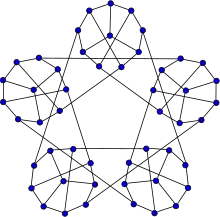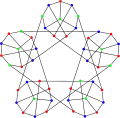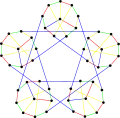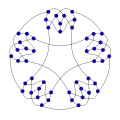Szekeres snark
In the mathematical field of graph theory, the Szekeres snark is a snark with 50 vertices and 75 edges.[1] It was the fifth known snark, discovered by George Szekeres in 1973.[2]
| Szekeres snark | |
|---|---|
 The Szekeres snark | |
| Named after | George Szekeres |
| Vertices | 50 |
| Edges | 75 |
| Radius | 6 |
| Diameter | 7 |
| Girth | 5 |
| Automorphisms | 20 |
| Chromatic number | 3 |
| Chromatic index | 4 |
| Book thickness | 3 |
| Queue number | 2 |
| Properties | Snark Hypohamiltonian |
| Table of graphs and parameters | |
As a snark, the Szekeres graph is a connected, bridgeless cubic graph with chromatic index equal to 4. The Szekeres snark is non-planar and non-hamiltonian but is hypohamiltonian.[3] It has book thickness 3 and queue number 2.[4]
Another well known snark on 50 vertices is the Watkins snark discovered by John J. Watkins in 1989.[5]
Gallery
 The chromatic number of the Szekeres snark is 3.
The chromatic number of the Szekeres snark is 3. The chromatic index of the Szekeres snark is 4.
The chromatic index of the Szekeres snark is 4. Alternative drawing of the Szekeres snark.
Alternative drawing of the Szekeres snark.
References
- Weisstein, Eric W. "Szekeres Snark". MathWorld.
- Szekeres, G. (1973). "Polyhedral decompositions of cubic graphs". Bull. Austral. Math. Soc. 8 (3): 367–387. doi:10.1017/S0004972700042660.
- Weisstein, Eric W. "Hypohamiltonian Graph". MathWorld.
- Wolz, Jessica; Engineering Linear Layouts with SAT. Master Thesis, University of Tübingen, 2018
- Watkins, J. J. "Snarks." Ann. New York Acad. Sci. 576, 606-622, 1989.
This article is issued from Wikipedia. The text is licensed under Creative Commons - Attribution - Sharealike. Additional terms may apply for the media files.